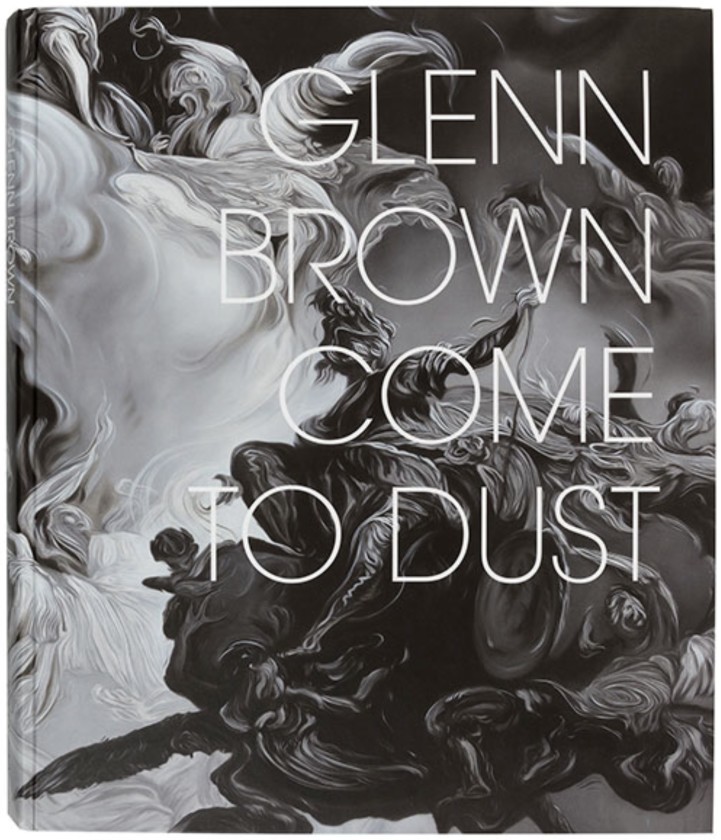Glenn Brown: Come to Dust: Gagosian Gallery, Grosvenor Hill, London
"I use pre-existing images to go into pre-existing frames. I don’t like a blank canvas or a blank sheet of paper." —Glenn Brown
Gagosian is pleased to present "Come to Dust," Glenn Brown's first major exhibition in London since 2009.
For Brown, one of Britain's most renowned contemporary artists, the past and present are treasuries of raw material, offering countless images, titles, and techniques to be combined, appropriated, and deconstructed. Mining an extensive knowledge of art history, as well as of literature, music, and popular culture, Brown creates complex and sensuous works of art that are resolutely of our time.
The title of exhibition, taken from a song in Shakespeare's play Cymbeline, evokes the ineluctability of death. The exhibition, comprising oil paintings, drawings in period frames, grisaille panel works, etchings, and sculptures, attests to the ever-intensifying dexterity with which Brown employs paint, content, and form. It teems with contrasts and contradictions, collapsing time, and allowing different, often opposing, references to exist simultaneously. Sources include Rembrandt, Delacroix, Greuze, and Raphael, as well as Abraham Bloemaert, Francesco Mancini, Gaetano Gandolfi, Elisabeth Le Brun, and Bernardo Cavallino.
In Brown's oil paintings, hybrid figures painted in intricate swirls reveal the sumptuous potential of oil paint. While these paintings give the illusion of corporeal volume and fullness, closer scrutiny reveals the surfaces to be deceptively smooth and flat. Painted flesh deliquesces, rots, and glows with a vital force. Rather than using paint to depict skin with observational exactitude, Brown shows the medium itself to be full of visceral life; translucent brushstrokes reveal the flesh, muscle, and sinew beneath the surface.
In Die Mutter des Künstlers [The Artist's Mother] (2016), a female nude offers her hand, her finger dripping blood (presumably from a visible wound on her side) in a gesture that is both maternal and Christ-like, but with a sickly, accusative edge. Not only does Brown distort the proportions of the figure from Eugene Delacroix's Nu Feminin assis (Mademoiselle Rose) (1820), he also removes the figure's head, plunging the viewer into his own alternate reality. Bathing the painting in bluish tones (an evident nod to Picasso's Blue Period), Brown asserts the history of art to be dynamic, not static. Another headless figure is visible in the gut-wrenching work titled Passchendaele (2017), in which an heroic male figure derived from another Delacroix work strides resolutely forward against a background of greens and yellows, colors that subvert the ideals of French Romanticism. Brown does not merely appropriate his source images, he fragments and infects them, introducing saturated hues that appear almost photo-luminescent. A series of new and grandiose grisaille panel paintings, based on small oil sketches and completely devoid of color, distort their subjects into grotesque parodies of altar paintings. In Music of the Mountains (2016), a graphic work on panel, Brown paints using only black and white lines over a neutral ground. Sharp, elongated strokes are layered meticulously and deliberately as Brown skillfully overlays and intermingles portrait heads from Raphael and Guido Reni to create depth and animation on a fused yet fractured entity that hovers between representation and dissolution, tranquility and unrest.
Brown's choice of picture frames adds an additional layer to the richly layered visual anachronism. Inverting the normal order of image-making and framing, Brown treats the frames as readymades, creating drawings in response to the particular color, size, design, and narrative detail of each. Thus, the drawings and the frames are integral to each other. In the exhibition, an entire room of recent drawings is hung salon-style, some mounted in elaborate Renaissance gilt and carved wooden frames.
Brown's sculptures are highly compelling, elaborate masses built from precisely placed strokes of very thick oil paint. In some of them, the cold, sensuous curves of nineteenth-century bronze statues are still visible but engulfed by growths of pulsating, gravity-defying oil paint. The cold, hard metal contrasts with the soft, luscious paint. Ain't No Flies on the Lamb of God (2017) is comprised of three truncated, upside-down feet, smothered in paint. Inspired by the motifs of painter Georg Baselitz, they are also an absurdist interpretation of the Crucifixion.
Merging the captivating and the uncanny, the beautiful and the repugnant, "Come to Dust" immerses the viewer in Brown's enigmatic world. The figures and forms of history mutate and evanesce, overtaken by hypnotic terrains of color and suffused in delirious, otherworldly light. Harnessing and transforming the allure of Old Master paintings and drawings, then steeping it in reverence and profanity, Brown tells a much darker and more complicated story, fit for our times.
The exhibition will be accompanied by a fully illustrated catalogue that includes an essay by novelist Hari Kunzru.
Glenn Brown was born in 1966 in Northumberland, England and lives in London and Suffolk. Institutional collections include the Arts Council Collection, London; British Museum, London; The Laing Art Gallery, England; the New Art Gallery, England; Zabludowicz Collection, London; Centre Georges Pompidou, Paris; Fondazione Sandretto Re Rebaudengo, Turin; FRAC Limousin, France; the Art Institute of Chicago; Museum of Modern Art, New York; Rennie collection, Vancouver; Des Moines Art Centre, Iowa and the Walker Art Center; Minneapolis. Recent exhibitions include the 50th Biennale di Venezia (2003); Kunsthistorisches Museum, Vienna (2008); Tate Liverpool, England (2009, traveled to Fondazione Sandretto Re Rebaudengo, Italy; and Museum Ludwig, Budapest, through 2010); Gwangju Biennale (2010); Upton House, England (2012); "Conversation Piece V," Frans Hals Museum, the Netherlands (2013-14); Des Moines Art Center, Iowa (2016, traveled to Contemporary Arts Center, Cincinnati); "Glenn Brown/Vincent Van Gogh: Suffer Well," Fondation Vincent Van Gogh Arles, France (2016); "Glenn Brown/Rembrandt: After Life," Rembrandt House Museum, Amsterdam (2017); and "Piaceri Sconosciuti," Museo Stefano Bardini, Florence (2017).
Glenn Brown: "Come to Dust"
Gagosian, 20 Grosvenor Hill, London W1K 3QD
January 24-March 17, 2018
Opening reception: Tuesday, January 23, 6-8pm
Photo credits:
Work images: Mike Bruce
Installation images: Lucy Dawkins
Artworks
-
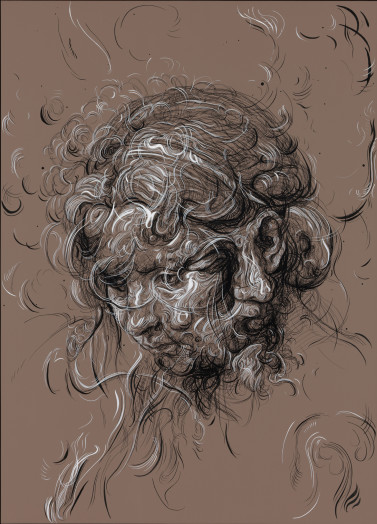 Glenn BrownDungeness B, 2016Indian ink and acrylic on panel132 x 95 x 2.8 cm (52 x 37 3/8 x 1 1/8 in)
Glenn BrownDungeness B, 2016Indian ink and acrylic on panel132 x 95 x 2.8 cm (52 x 37 3/8 x 1 1/8 in) -
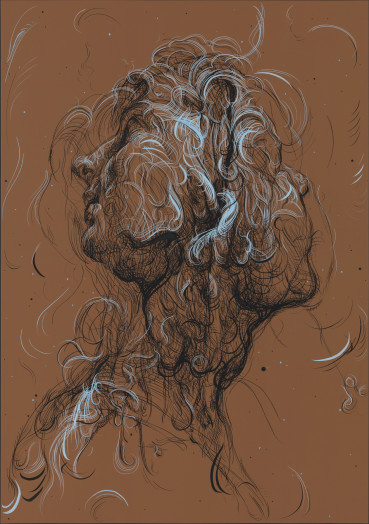 Glenn BrownHubcap Diamond Star Halo, 2017Acrylic paint on panel135 x 94.9 x 2.2 cm (53 1/8 x 37 3/8 x 7/8 in)
Glenn BrownHubcap Diamond Star Halo, 2017Acrylic paint on panel135 x 94.9 x 2.2 cm (53 1/8 x 37 3/8 x 7/8 in) -
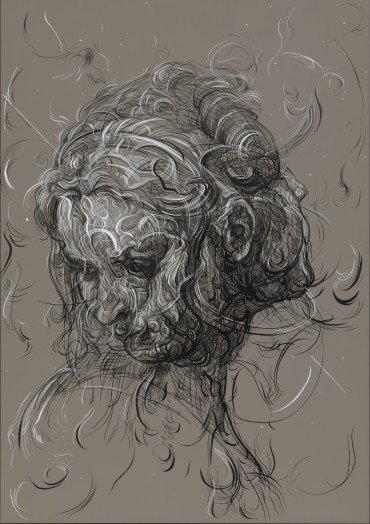 Glenn BrownThe Music of the Mountains, 2016Indian ink and acrylic on panel135 x 95 x 3 cm (53 1/8 x 37 3/8 x 1 1/8 in)
Glenn BrownThe Music of the Mountains, 2016Indian ink and acrylic on panel135 x 95 x 3 cm (53 1/8 x 37 3/8 x 1 1/8 in) -
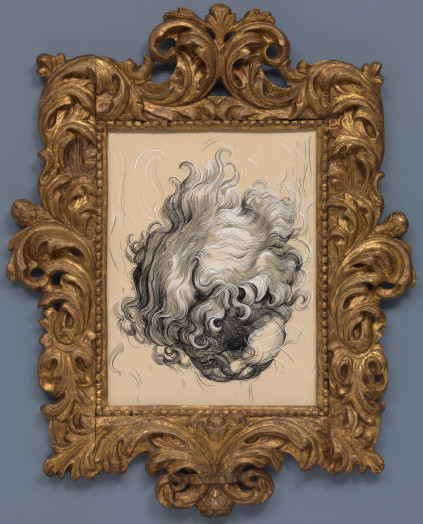 Glenn BrownFat Boy (1945), 2018Indian ink and acrylic paint on film over panel, frame71.1 x 55.1 cm (28 x 21 3/4 in) sheet size
Glenn BrownFat Boy (1945), 2018Indian ink and acrylic paint on film over panel, frame71.1 x 55.1 cm (28 x 21 3/4 in) sheet size
-
 Glenn BrownThis Island Earth, 2017Oil paint on panel274 x 183 x 2.2 cm (107 7/8 x 72 1/8 x 7/8 in)
Glenn BrownThis Island Earth, 2017Oil paint on panel274 x 183 x 2.2 cm (107 7/8 x 72 1/8 x 7/8 in) -
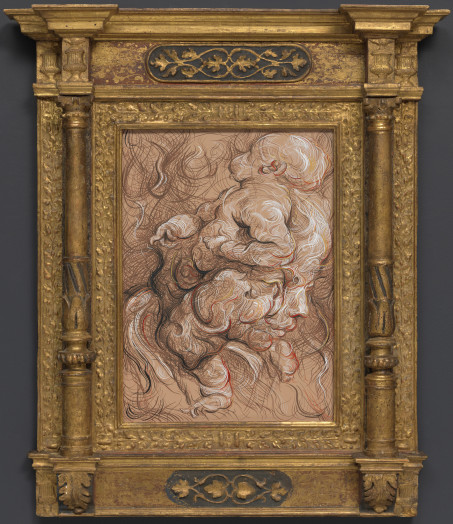 Glenn BrownMother's Tongue, 2017acrylic paint on panel, frame56.4 x 41 cm (22 1/4 x 16 1/8 in) panel size
Glenn BrownMother's Tongue, 2017acrylic paint on panel, frame56.4 x 41 cm (22 1/4 x 16 1/8 in) panel size -
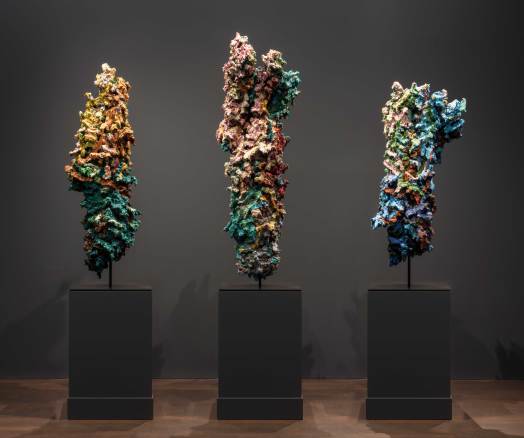 Glenn BrownAin't No Flies on the Lamb of God, 2017Oil paint on acrylic, fibreglass and stainless steel on bronze base219 x 50 x 40 cm (86 1/8 x 19 5/8 x 15 3/4 in) left
Glenn BrownAin't No Flies on the Lamb of God, 2017Oil paint on acrylic, fibreglass and stainless steel on bronze base219 x 50 x 40 cm (86 1/8 x 19 5/8 x 15 3/4 in) left
235 x 62 x 60 (92 1/2 x 24 3/8 x 23 5/8 in) centre
206 x 60 x 42 cm (81 1/8 x 23 5/8 x 16 1/2) right -
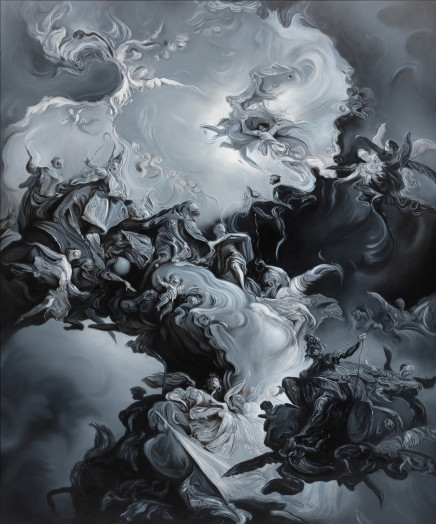 Glenn BrownLet's Make Love and Listen to Death from Above, 2017Oil on panel231 x 192 x 2.8 cm (91 x 75 5/8 x 1 1/8 in)
Glenn BrownLet's Make Love and Listen to Death from Above, 2017Oil on panel231 x 192 x 2.8 cm (91 x 75 5/8 x 1 1/8 in)
-
Glenn BrownHot Love, 2017Oil on panel125 x 110 x 2.2 cm (49 1/4 x 43 1/4 x 7/8 in)
-
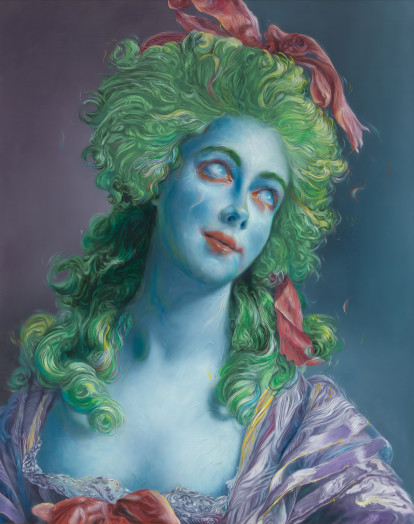 Glenn BrownLife on the Moon, 2016Oil on panel100 x 78.5 cm
Glenn BrownLife on the Moon, 2016Oil on panel100 x 78.5 cm -
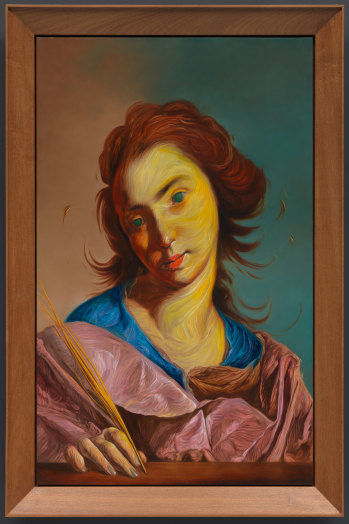 Glenn BrownCome to Dust, 2017oil on panel115 x 71 cm (45 1/4 x 28 in)
Glenn BrownCome to Dust, 2017oil on panel115 x 71 cm (45 1/4 x 28 in) -
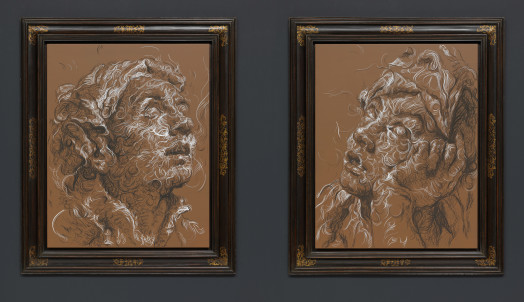 Glenn BrownI was here for a moment, and then I was gone, 2017acrylic paint on panel, frame (diptych)75 x 60 cm (29 1/2 x 23 5/8 in) each panel
Glenn BrownI was here for a moment, and then I was gone, 2017acrylic paint on panel, frame (diptych)75 x 60 cm (29 1/2 x 23 5/8 in) each panel
-
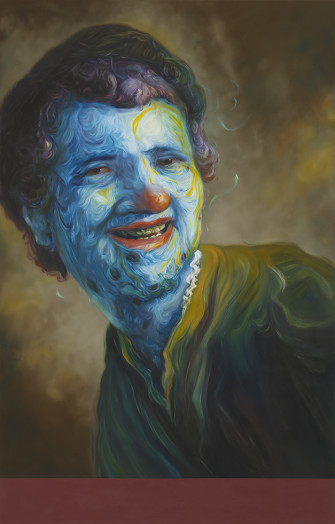 Glenn BrownThey Slipped the Surly Bonds of Earth and Touched the Face of God, 2017Oil on panel128.5 x 82.5 x 2.2 cm (50 5/8 x 32 1/2 x 7/8 in)
Glenn BrownThey Slipped the Surly Bonds of Earth and Touched the Face of God, 2017Oil on panel128.5 x 82.5 x 2.2 cm (50 5/8 x 32 1/2 x 7/8 in) -
 Glenn BrownPoor Art, 2016Oil on panel108.5 x 74 x 2.2 cm (42 3/4 x 29 1/8 x 7/8 in)
Glenn BrownPoor Art, 2016Oil on panel108.5 x 74 x 2.2 cm (42 3/4 x 29 1/8 x 7/8 in) -
 Glenn BrownSepulchre Culture, 2018Oil paint on acrylic, fibreglass and stainless steel, bronze base143.25 x 45 x 55 cm (56 3/8 x 17 3/4 x 21 5/8 in)
Glenn BrownSepulchre Culture, 2018Oil paint on acrylic, fibreglass and stainless steel, bronze base143.25 x 45 x 55 cm (56 3/8 x 17 3/4 x 21 5/8 in) -
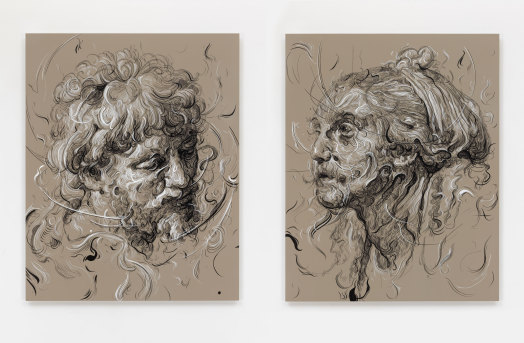 Glenn BrownSizewell C, 2016Indian ink and acrylic on panel, diptycheach 75 x 60 cm
Glenn BrownSizewell C, 2016Indian ink and acrylic on panel, diptycheach 75 x 60 cm
-
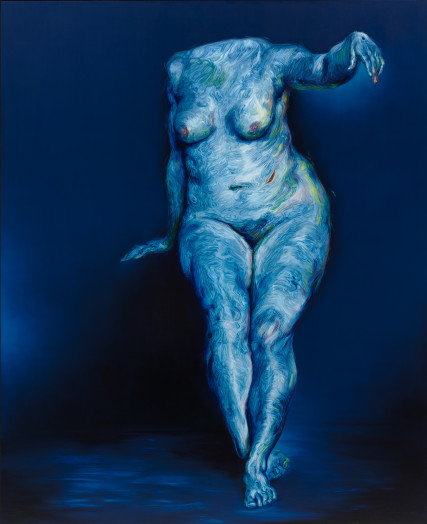 Glenn BrownDie Mutter des Kunstlers, 2016Oil on panel200 x 162 cm (78 3/4 x 63 3/4 in)
Glenn BrownDie Mutter des Kunstlers, 2016Oil on panel200 x 162 cm (78 3/4 x 63 3/4 in) -
 Glenn BrownLet me ferry you out to sea To see who you could have been When the time comes to row back in You'll be in the place you should have been, 2017Oil paint and acrylic on bronze84 x 74 x 66 cm (33 1/8 x 29 1/8 x 26 in)
Glenn BrownLet me ferry you out to sea To see who you could have been When the time comes to row back in You'll be in the place you should have been, 2017Oil paint and acrylic on bronze84 x 74 x 66 cm (33 1/8 x 29 1/8 x 26 in) -
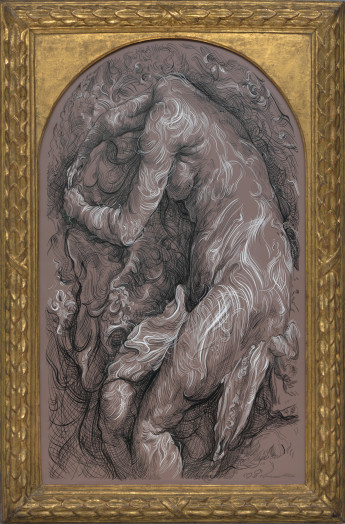 Glenn BrownChildren of the Revolution (after Rembrandt), 2017Indian ink and acrylic on polyester film, over cardboard96.4 x 57.4 cm (38 x 22 5/8 in) (rounded top corners) sheet size
Glenn BrownChildren of the Revolution (after Rembrandt), 2017Indian ink and acrylic on polyester film, over cardboard96.4 x 57.4 cm (38 x 22 5/8 in) (rounded top corners) sheet size -
 Glenn BrownDrawing 18 (after Boucher), 2017Indian ink and acrylic paint on film over panel, frame29.4 x 19.4 cm (11 5/8 x 7 5/8 in) sheet size
Glenn BrownDrawing 18 (after Boucher), 2017Indian ink and acrylic paint on film over panel, frame29.4 x 19.4 cm (11 5/8 x 7 5/8 in) sheet size
-
 Glenn BrownDrawing 11 (after Tiepolo), 2017Indian ink and acrylic on polyester film, over cardboard38.2 x 29.5 cm (15 1/8 x 11 5/8 in)
Glenn BrownDrawing 11 (after Tiepolo), 2017Indian ink and acrylic on polyester film, over cardboard38.2 x 29.5 cm (15 1/8 x 11 5/8 in) -
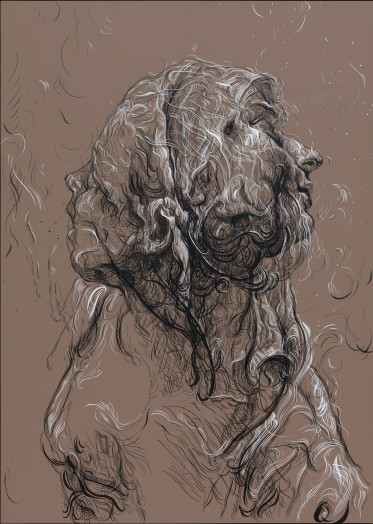 Glenn BrownTorness One, 2016Indian ink and acrylic on panel112 x 80 x 2.2 cm (44 1/8 x 31 1/2 x 7/8 in)
Glenn BrownTorness One, 2016Indian ink and acrylic on panel112 x 80 x 2.2 cm (44 1/8 x 31 1/2 x 7/8 in) -
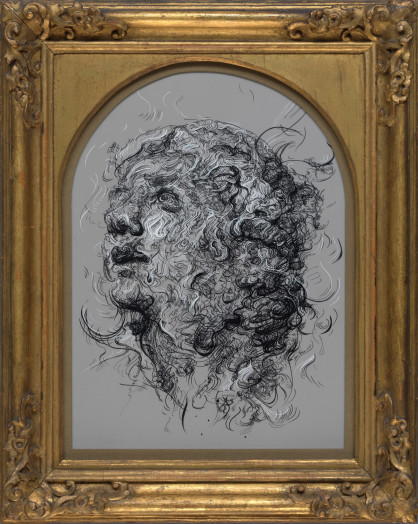 Glenn BrownDrawing 3 (after Tiepolo/Tiepolo), 2017Indian ink and acrylic on polyester film, over cardboard42 x 29.8 cm (16 1/2 x 11 3/4 in)
Glenn BrownDrawing 3 (after Tiepolo/Tiepolo), 2017Indian ink and acrylic on polyester film, over cardboard42 x 29.8 cm (16 1/2 x 11 3/4 in) -
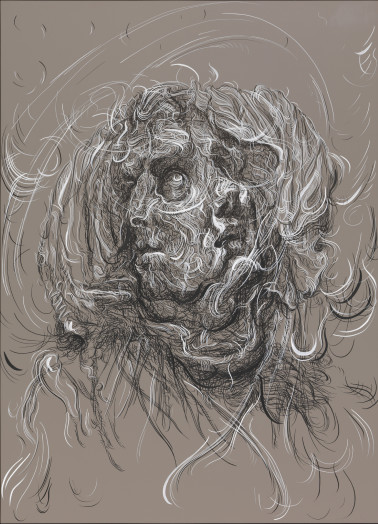 Glenn BrownGet it On, 2017Acrylic paint on panel132 x 95 x 2.2 cm (52 x 37 3/8 x 7/8 in)
Glenn BrownGet it On, 2017Acrylic paint on panel132 x 95 x 2.2 cm (52 x 37 3/8 x 7/8 in)
-
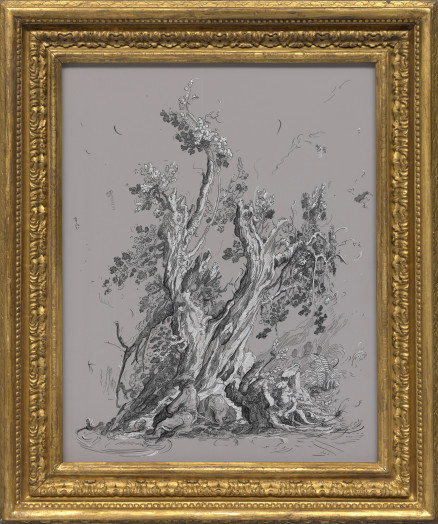 Glenn BrownDrawing 1 (after Bloemaert), 2017Indian ink and acrylic on polyester film, over cardboard49.8 x 37.9 cm (19 5/8 x 14 7/8 in) sheet size
Glenn BrownDrawing 1 (after Bloemaert), 2017Indian ink and acrylic on polyester film, over cardboard49.8 x 37.9 cm (19 5/8 x 14 7/8 in) sheet size -
 Glenn BrownDrawing 23 (after Murillo/Murillo) , 2018acrylic paint on film over panel, frame83.3 x 63.4 cm (32 3/4 x 25 in) sheet size
Glenn BrownDrawing 23 (after Murillo/Murillo) , 2018acrylic paint on film over panel, frame83.3 x 63.4 cm (32 3/4 x 25 in) sheet size -
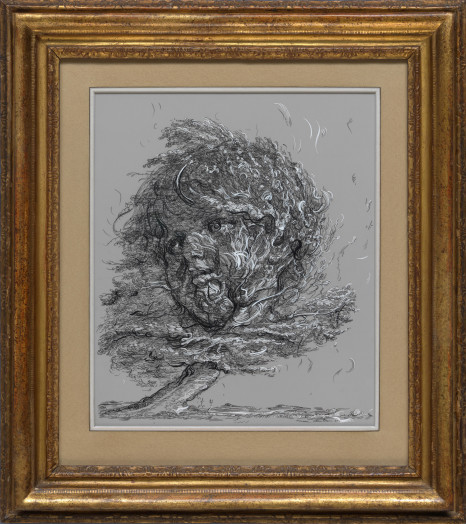 Glenn BrownDrawing 4 (after De Gheyn II/Greuze), 2017Indian ink and acrylic on polyester film, over cardboard39.7 x 29.7 cm (15 5/8 x 11 3/4 in) sheet size
Glenn BrownDrawing 4 (after De Gheyn II/Greuze), 2017Indian ink and acrylic on polyester film, over cardboard39.7 x 29.7 cm (15 5/8 x 11 3/4 in) sheet size -
 Glenn BrownDrawing 4 (after Bloemaert), 2018Indian ink and acrylic paint on film over panel, frame75.5 x 51.8 cm (29 3/4 x 20 3/8 in) sheet size
Glenn BrownDrawing 4 (after Bloemaert), 2018Indian ink and acrylic paint on film over panel, frame75.5 x 51.8 cm (29 3/4 x 20 3/8 in) sheet size
-
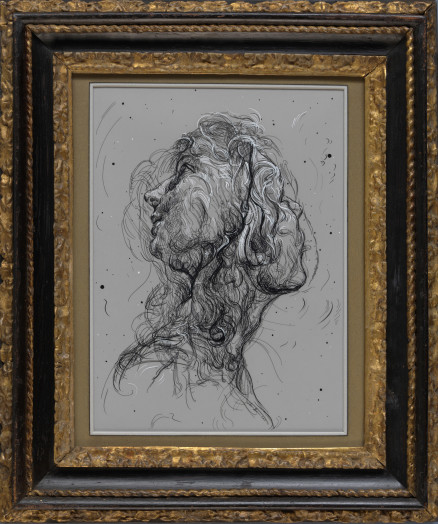 Glenn BrownDrawing 12 (after Batoni/Del Sarto), 2017Indian ink and acrylic on polyester film, over cardboard40.2 x 29.6 cm (15 7/8 x 11 5/8 in) sheet size
Glenn BrownDrawing 12 (after Batoni/Del Sarto), 2017Indian ink and acrylic on polyester film, over cardboard40.2 x 29.6 cm (15 7/8 x 11 5/8 in) sheet size -
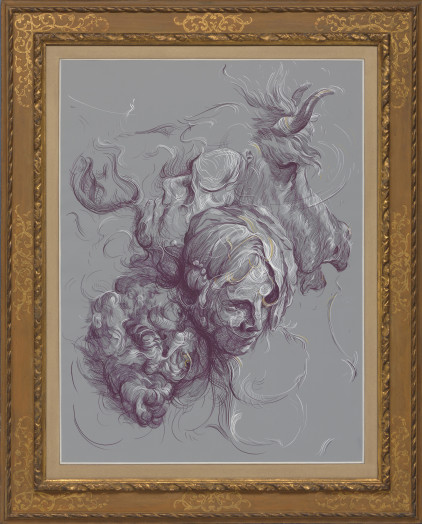 Glenn BrownOh well, enough said, bring on the dead, 2018acrylic paint on film over panel, frame111.9 x 84 cm (44 1/8 x 33 1/8 in) sheet size
Glenn BrownOh well, enough said, bring on the dead, 2018acrylic paint on film over panel, frame111.9 x 84 cm (44 1/8 x 33 1/8 in) sheet size -
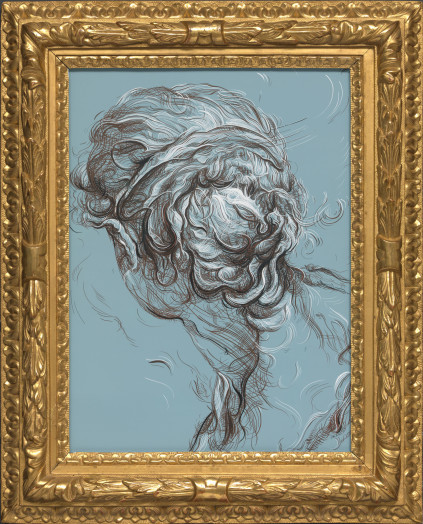 Glenn BrownHarpoon, 2018acrylic paint on panel, frame61.6 x 46.4 cm (24 1/4 x 18 1/4 in) panel size
Glenn BrownHarpoon, 2018acrylic paint on panel, frame61.6 x 46.4 cm (24 1/4 x 18 1/4 in) panel size -
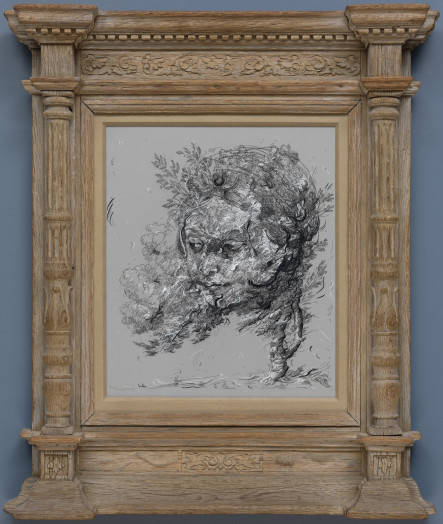 Glenn BrownDrawing 13 (after Grimaldi/Reni) , 2017Indian ink and acrylic on polyester film, over cardboard39.2 x 29.8 cm (15 3/8 x 11 3/4 in)
Glenn BrownDrawing 13 (after Grimaldi/Reni) , 2017Indian ink and acrylic on polyester film, over cardboard39.2 x 29.8 cm (15 3/8 x 11 3/4 in)
-
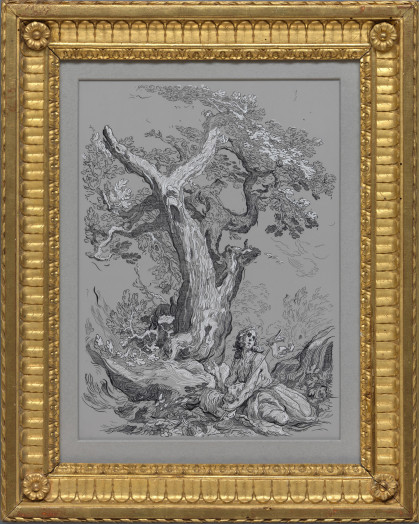 Glenn BrownDrawing 2 (after Bloemaert) , 2017Indian ink and acrylic on polyester film, over cardboard46.3 x 34.3 cm (18 1/4 x 13 1/2 in) sheet size
Glenn BrownDrawing 2 (after Bloemaert) , 2017Indian ink and acrylic on polyester film, over cardboard46.3 x 34.3 cm (18 1/4 x 13 1/2 in) sheet size -
 Glenn BrownStimulate the Beaded Hamster, 2017acrylic paint on panel, frame71.2 x 59.5 cm (28 1/8 x 23 3/8 in) panel size
Glenn BrownStimulate the Beaded Hamster, 2017acrylic paint on panel, frame71.2 x 59.5 cm (28 1/8 x 23 3/8 in) panel size -
 Glenn BrownDrawing 1 (after Bloemaert) , 2017Indian ink and acrylic paint on film over panel, frame45.9 x 64.2 cm (18 1/8 x 25 1/4 in) sheet size
Glenn BrownDrawing 1 (after Bloemaert) , 2017Indian ink and acrylic paint on film over panel, frame45.9 x 64.2 cm (18 1/8 x 25 1/4 in) sheet size -
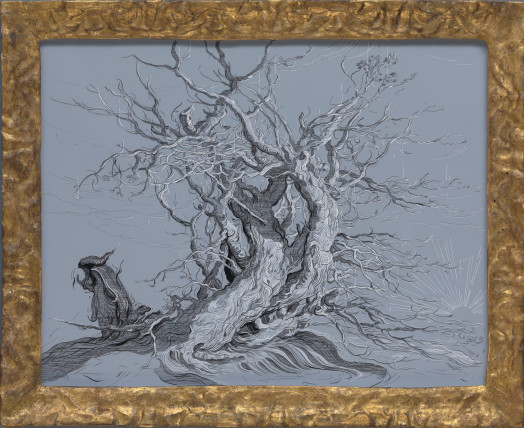 Glenn BrownDrawing 2 (after Bloemaert) , 2018Indian ink and acrylic paint on film over panel, frame50.4 x 62.7 cm (19 7/8 x 24 3/4 in) sheet size
Glenn BrownDrawing 2 (after Bloemaert) , 2018Indian ink and acrylic paint on film over panel, frame50.4 x 62.7 cm (19 7/8 x 24 3/4 in) sheet size
-
 Glenn BrownDrawing 5 (after Bloemaert), 2016Indian ink and acrylic on polyester film, over cardboard58.7 x 42.1 cm (23 1/8 x 16 5/8 in) sheet size
Glenn BrownDrawing 5 (after Bloemaert), 2016Indian ink and acrylic on polyester film, over cardboard58.7 x 42.1 cm (23 1/8 x 16 5/8 in) sheet size -
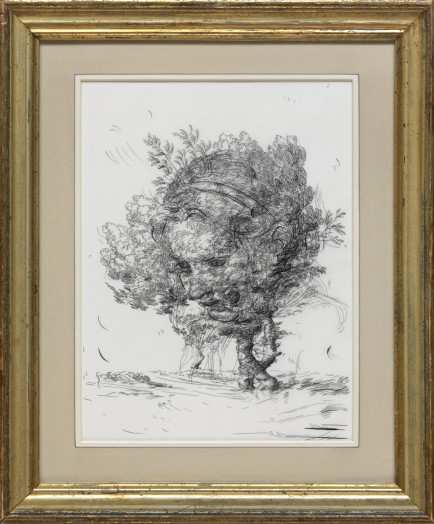 Glenn BrownDrawing 6 (after De Gheyn II/Greuze), 2017Indian ink on polyester film, over cardboard42.1 x 29.7 cm (16 5/8 x 11 3/4 in) sheet size
Glenn BrownDrawing 6 (after De Gheyn II/Greuze), 2017Indian ink on polyester film, over cardboard42.1 x 29.7 cm (16 5/8 x 11 3/4 in) sheet size -
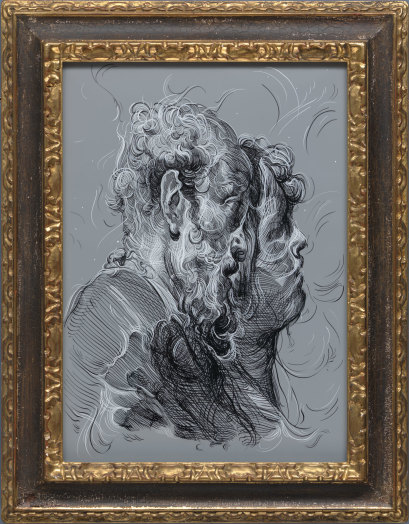 Glenn BrownDrawing 15 (after Gandolfi) , 2017Indian ink and acrylic paint on film, frame52.4 x 36.9 cm (20 5/8 x 14 1/2 in) sheet size
Glenn BrownDrawing 15 (after Gandolfi) , 2017Indian ink and acrylic paint on film, frame52.4 x 36.9 cm (20 5/8 x 14 1/2 in) sheet size -
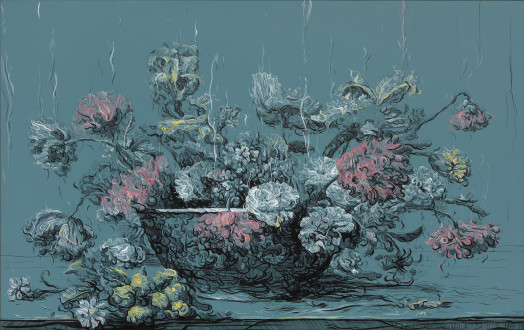 Glenn BrownDarsham Songs, 2016Oil, indian ink and acrylic on panel82 x 129.5 cm
Glenn BrownDarsham Songs, 2016Oil, indian ink and acrylic on panel82 x 129.5 cm
-
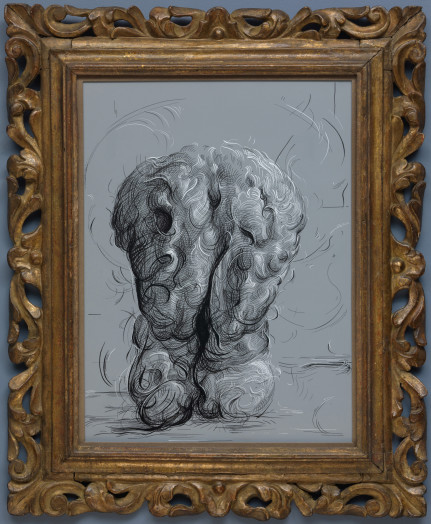 Glenn BrownDrawing 5 (after Goltzius), 2017Indian ink and acrylic on polyester film, over cardboard54.3 x 39.9 cm (21 3/8 x 15 3/4 in)
Glenn BrownDrawing 5 (after Goltzius), 2017Indian ink and acrylic on polyester film, over cardboard54.3 x 39.9 cm (21 3/8 x 15 3/4 in) -
Glenn BrownDrawing 19 (after Van Noordt), 2017Indian ink and acrylic paint on film, frame32.8 x 22.9 cm (12 7/8 x 9 1/8 in)
-
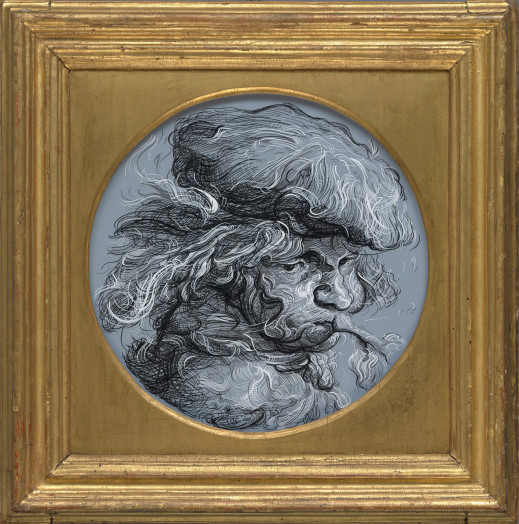 Glenn BrownDrawing 14 (after Castiglioni), 2017Indian ink and acrylic on polyester film, over cardboard (round)40.6 cm diametre sheet
Glenn BrownDrawing 14 (after Castiglioni), 2017Indian ink and acrylic on polyester film, over cardboard (round)40.6 cm diametre sheet -
 Glenn BrownRide a White Swan, 2017Indian ink and acrylic on panel190 x 151 x 3 cm (74 3/4 x 59 1/2 x 1 1/8 in)
Glenn BrownRide a White Swan, 2017Indian ink and acrylic on panel190 x 151 x 3 cm (74 3/4 x 59 1/2 x 1 1/8 in)
-
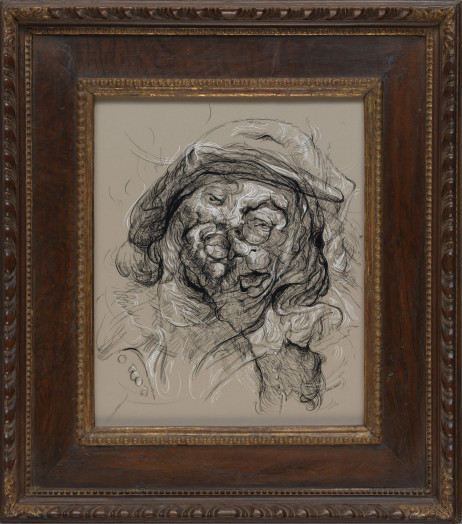 Glenn BrownDrawing 24 (after Jordaens/Jordaens), 2017Indian ink and acrylic paint on film over panel, frame37.3 x 31.4 cm (14 3/4 x 12 3/8 in) sheet size
Glenn BrownDrawing 24 (after Jordaens/Jordaens), 2017Indian ink and acrylic paint on film over panel, frame37.3 x 31.4 cm (14 3/4 x 12 3/8 in) sheet size -
 Glenn BrownNostalgia, 2016Indian ink and acrylic on panel84 x 60 x 2.2 cm (33 1/8 x 23 5/8 x 7/8 in)
Glenn BrownNostalgia, 2016Indian ink and acrylic on panel84 x 60 x 2.2 cm (33 1/8 x 23 5/8 x 7/8 in) -
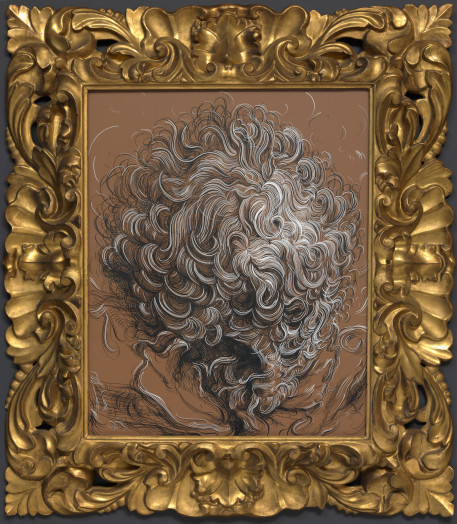 Glenn BrownBread and Circus, 2018acrylic paint on panel, frame84.9 x 69 cm (33 3/8 x 27 1/8 in) panel size
Glenn BrownBread and Circus, 2018acrylic paint on panel, frame84.9 x 69 cm (33 3/8 x 27 1/8 in) panel size -
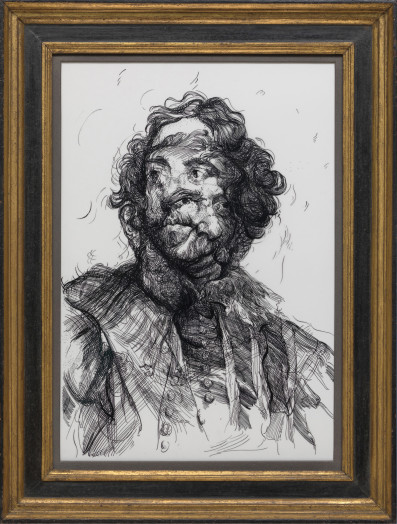 Glenn BrownDrawing 16 (after Van Dyck/Van Dyck), 2017Indian ink and acrylic paint on film over panel, frame53.3 x 37.5 cm (21 x 14 3/4 in) sheet size
Glenn BrownDrawing 16 (after Van Dyck/Van Dyck), 2017Indian ink and acrylic paint on film over panel, frame53.3 x 37.5 cm (21 x 14 3/4 in) sheet size
-
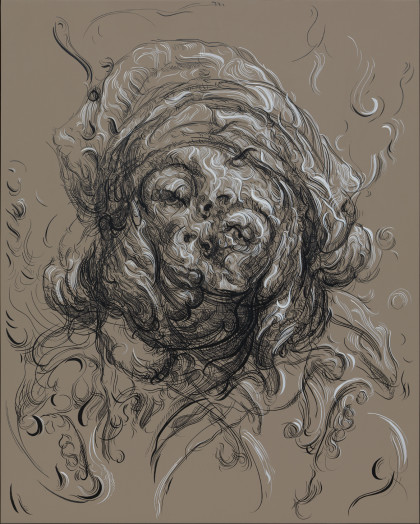 Glenn BrownPoor Moon, 2016Indian ink and acrylic on panel92 x 73.5 x 2.2 cm (36 1/4 x 29 x 7/8 in)
Glenn BrownPoor Moon, 2016Indian ink and acrylic on panel92 x 73.5 x 2.2 cm (36 1/4 x 29 x 7/8 in) -
 Glenn BrownDrawing 17 (after Rembrandt), 2017Indian ink and acrylic paint on film, frame62.8 x 52.4 cm (24 3/4 x 20 5/8 in) sheet size
Glenn BrownDrawing 17 (after Rembrandt), 2017Indian ink and acrylic paint on film, frame62.8 x 52.4 cm (24 3/4 x 20 5/8 in) sheet size -
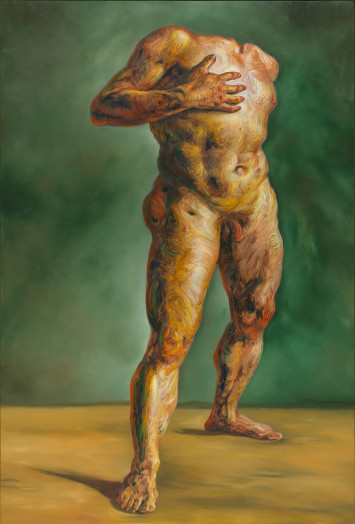 Glenn BrownPasschendaele, 2017Oil paint on panel204 x 138 cm (80 1/4 x 54 3/8 in)
Glenn BrownPasschendaele, 2017Oil paint on panel204 x 138 cm (80 1/4 x 54 3/8 in) -
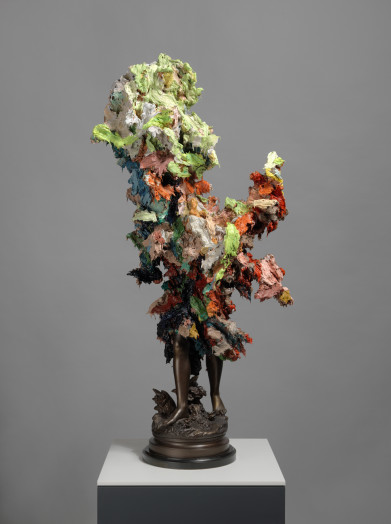 Glenn BrownWill you kiss me when I'm gone, 2018Oil and acrylic over bronze and metal, vitrine119 x 59 x 50 cm (46 7/8 x 23 1/4 x 19 3/4 in)
Glenn BrownWill you kiss me when I'm gone, 2018Oil and acrylic over bronze and metal, vitrine119 x 59 x 50 cm (46 7/8 x 23 1/4 x 19 3/4 in)
-
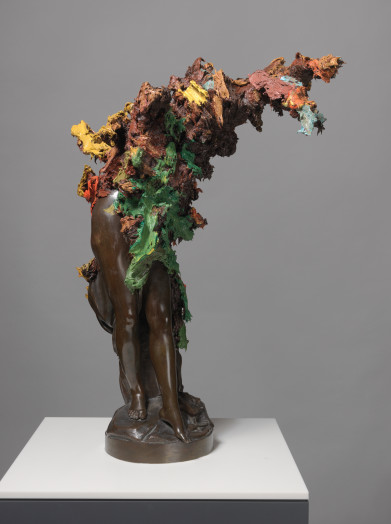 Glenn BrownUn piccolo divertimento, 2017Oil paint on bronze74 x 48 x 45 cm (29 1/8 x 18 7/8 x 17 3/4 in)
Glenn BrownUn piccolo divertimento, 2017Oil paint on bronze74 x 48 x 45 cm (29 1/8 x 18 7/8 x 17 3/4 in) -
Glenn BrownOn the Way to the Leisure Centre, 2017Oil on panel122 x 244 x 2.2 cm (48 1/8 x 96 1/8 x 7/8 in)
-
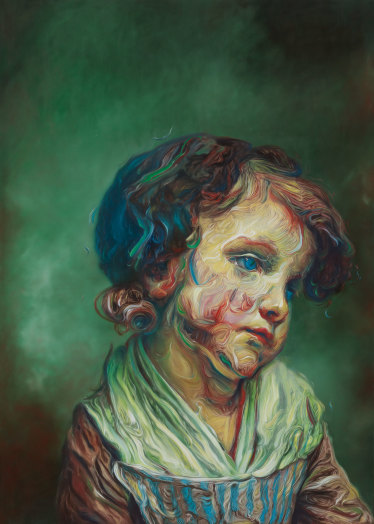 Glenn BrownDaydream Nation, 2017Oil on panel112 x 80 x 2.2 cm (44 1/8 x 31 1/2 x 7/8 in)
Glenn BrownDaydream Nation, 2017Oil on panel112 x 80 x 2.2 cm (44 1/8 x 31 1/2 x 7/8 in) -
 Glenn BrownTrivial Pursuit, 2017Oil paint and acrylic on bronze76 x 50 x 48 cm (29 7/8 x 19 3/4 x 18 7/8 in)
Glenn BrownTrivial Pursuit, 2017Oil paint and acrylic on bronze76 x 50 x 48 cm (29 7/8 x 19 3/4 x 18 7/8 in)
-
 Glenn BrownAmerican Sublime, 2017Oil and acrylic paint on bronze98.5 x 62 x 60 cm (38 3/4 x 24 3/8 x 23 5/8 in)
Glenn BrownAmerican Sublime, 2017Oil and acrylic paint on bronze98.5 x 62 x 60 cm (38 3/4 x 24 3/8 x 23 5/8 in) -
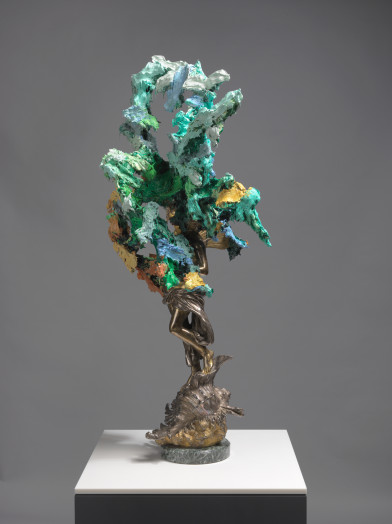 Glenn BrownLuscious Apparatus, 2017Oil paint on silvered and parcel gilt bronze, vitrine98 x 46 x 33 cm (38 5/8 x 18 1/8 x 13 in)
Glenn BrownLuscious Apparatus, 2017Oil paint on silvered and parcel gilt bronze, vitrine98 x 46 x 33 cm (38 5/8 x 18 1/8 x 13 in) -
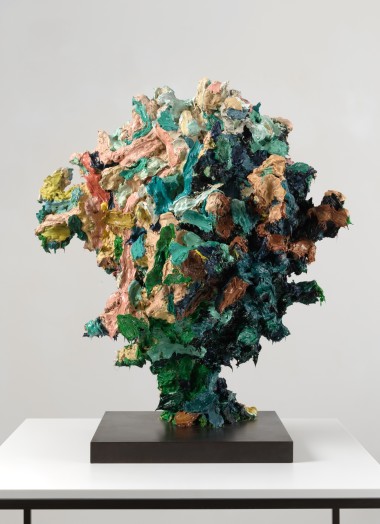 Glenn BrownL’Arlésienne, 2016Oil paint on fibreglass and stainless steel, bronze base, vitrine88.5 x 76 x 73 cm
Glenn BrownL’Arlésienne, 2016Oil paint on fibreglass and stainless steel, bronze base, vitrine88.5 x 76 x 73 cm -
 Glenn BrownUnknown Pleasures, 2016Oil on panel164 x 105.5 x 2.2 cm (64 5/8 x 41 1/2 x 7/8 in)
Glenn BrownUnknown Pleasures, 2016Oil on panel164 x 105.5 x 2.2 cm (64 5/8 x 41 1/2 x 7/8 in)

